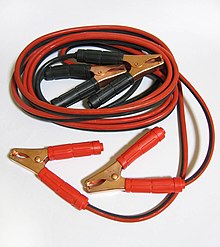Introduction and Features
– Crocodile clips are plier-like spring-tensioned metal clips with serrated jaws.
– They are used for creating temporary electrical connections.
– The name ‘crocodile clip’ comes from the resemblance of the jaws to those of a crocodile or alligator.
– The clips are used to clamp and grab onto bare electrical cables or leads.
– They function like spring-loaded clothespins, gripping objects with their serrated jaws.
– Crocodile clips are commonly used in electronics testing and evaluation.
– They are often crimped or soldered to wires for quick non-permanent connections.
– The clips can be used to connect circuits under test to laboratory equipment.
– Plastic shrouds or boots are used to prevent accidental short-circuits.
– Small versions of crocodile clips are used in electrical laboratory work.
Automotive and Battery Clamps
– Large versions of crocodile clips are known as automotive clips or battery clamps.
– They are made of solid copper for low electrical resistance.
– Automotive clips are used with thick insulated copper cables in automobile batteries.
– These clips are capable of delivering high currents needed for starting motors.
– They can transfer energy between charged and discharged batteries.
Specifications
– The United States Defense Logistics Agency specifies different types of electrical clips.
– Crocodile clips are designated as type CC in the Commercial Item Description (CID) A-A-59466.
– Alligator clips have different designations, such as TCx.
– Other types of electrical clips also have unique designations in the CID document.
– These specifications ensure standardized use and compatibility of electrical clips.
Other Uses
– Crocodile clips are used in dentistry to attach protective bibs over patients’ clothing.
– They are frequently used in laboratories for assembling or modifying experimental circuits.
– Crocodile clips are used in education to teach students about electricity.
– In fencing, they connect participants’ lamé vests to touch-detection systems.
– Hobbyists use crocodile clips as miniature clamps for gluing or soldering tasks.
None Source: https://en.wikipedia.org/wiki/Crocodile_clip
This article needs additional citations for verification. (May 2013) |
A crocodile clip or alligator clip is a plier-like spring-tensioned metal clip with elongated, serrated jaws that is used for creating a temporary electrical connection. This simple mechanical device gets its name from the resemblance of its serrated jaws to the toothed jaws of a crocodile or alligator. It is used to clamp and grab onto a bare electrical cable to a lead on a battery or some other electrical component. Functioning much like a spring-loaded clothespin, the clip's tapered, serrated jaws are forced together by a spring to grip an object. When manufactured for electronics testing and evaluation, one jaw of the clip is typically permanently crimped or soldered to a wire, or is bent to form the inner tubular contact of a ~4 mm (0.16 in) female banana jack, enabling quick non-permanent connection between a circuit under test and laboratory equipment or to another electrical circuit. The clip is typically covered by a plastic shroud or "boot" to prevent accidental short-circuits.




Small versions, ranging in size from 15–40 mm (0.59–1.57 in) in length, are used in electrical laboratory work.
Large versions of these clips, called automotive clips or battery clamps, are made of solid copper for low electrical resistance, and are used with thick insulated copper cables to make connections between automobile batteries. These jumper cables (a.k.a. 'jump leads') are capable of delivering hundreds of Amperes of current needed to directly power an automobile starter motor, or to transfer energy from a charged lead–acid battery to a discharged one.
